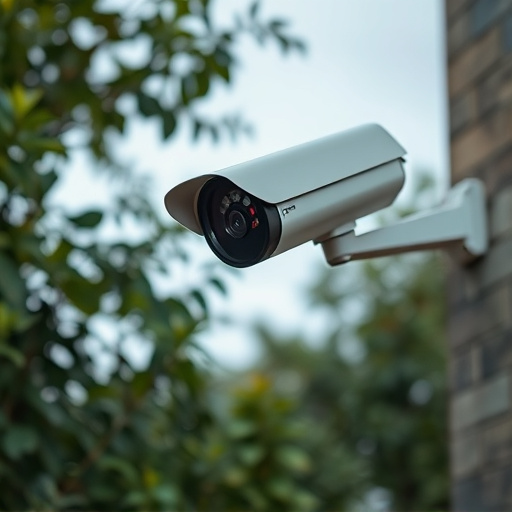Understanding your space and security needs is crucial when choosing between dome or bullet cameras for fake security systems. Strategically place cameras at eye level with a slight angle towards entrances in visible areas, preserving privacy by avoiding direct line-of-sight into homes. The "Fake Security Camera Angle Guide" offers insights on realistic positioning techniques to deter intruders and create the illusion of monitoring. After installation, thoroughly test connections, settings, audio, and video quality. Discreetly place cameras at suitable heights to capture areas without attracting attention, regularly testing functionality for effective, cost-efficient protection.
Deter criminals with a smartly installed fake security camera system. This comprehensive guide, titled “Fake Security Camera Angle Guide,” walks you through every step of setting up an effective surveillance network. From understanding different fake camera types and their strategic placement to assessing target areas and connecting the system for optimal performance, this angle guide ensures your property remains secure. Discover expert tips on maintaining discretion while achieving robust security.
- Understanding Fake Security Camera Types and Their Placement
- Assessing the Target Area: Identifying Ideal Camera Angles
- Setting Up the Camera: A Step-by-Step Process
- Connecting and Testing the System: Ensuring Optimal Performance
- Tips for Maintaining Discretion and Effective Surveillance
Understanding Fake Security Camera Types and Their Placement
When considering a fake security camera installation, it’s crucial to understand the various types available and their ideal placement. These faux cameras come in different forms, each designed to mimic real surveillance equipment, offering a range of angles and features. From fixed-angle models that provide broad coverage to adjustable ones that can capture specific areas, selecting the right type depends on your space and security needs.
For instance, if you want to deter potential intruders in a wide-open area like a yard or parking lot, a dome camera with its 360-degree view might be ideal. On the other hand, for smaller spaces like a porch or entry way, a bullet camera offering a zoom feature could be more suitable. Placement is key; positioning these fake cameras at strategic locations can enhance security while maintaining an aesthetic appearance.
Assessing the Target Area: Identifying Ideal Camera Angles
When setting up a fake security camera system, understanding your target area and choosing the right angles is crucial for an effective deterrent. Begin by assessing the space thoroughly; consider factors like lighting, visibility, and common entry points. Observe the flow of people and vehicles to identify areas that need maximum coverage. For instance, in a front yard, positioning cameras at eye level and slightly angled towards the entrance can deter potential intruders effectively.
The ideal camera angles should provide clear, unobstructed views while maintaining privacy. Avoid direct line-of-sight into homes or sensitive areas. Instead, focus on strategic placement that captures key features without compromising secrecy. A well-placed fake security camera in a visible yet concealed spot can significantly enhance home safety and act as a powerful psychological deterrent for would-be intruders.
Setting Up the Camera: A Step-by-Step Process
Connecting and Testing the System: Ensuring Optimal Performance
After installing your fake security camera, it’s crucial to connect and test the system thoroughly for optimal performance. Start by plugging in the camera’s power cable and ensuring it’s securely attached to a stable surface. Next, connect the camera to your network using the provided Ethernet cable or Wi-Fi. Verify the connection by checking if the camera appears on your network map.
Once connected, access the camera’s settings and adjust the angle, zoom, and resolution for optimal viewing. Test the audio functionality by speaking into the microphone and check the video feed quality. Ensure the camera captures clear images under various lighting conditions. Regular testing and adjustments will ensure your fake security camera operates effectively, providing the peace of mind you’re looking for in a fraction of the cost.
Tips for Maintaining Discretion and Effective Surveillance
To maintain discretion while installing fake security cameras, pay close attention to their placement and angle. Positioning them in plain sight can negate the entire purpose, so aim for subtle locations that mimic genuine camera setups. Place them high enough to capture a wide area but not too prominent, ensuring they blend seamlessly into the environment.
The Fake Security Camera Angle Guide is your ally here; use it to understand the ideal viewing angles and cover more ground without drawing unnecessary attention. Regularly test their functionality and adjust as needed, keeping up with industry standards for surveillance effectiveness while maintaining a level of secrecy that deterrs potential intruders.
The installation of fake security cameras offers a clever way to enhance surveillance without compromising discretion. By understanding the various types, assessing your target area for optimal angles, and following a structured setup process, you can create an effective deterrent. Regular maintenance ensures these decoys remain functional, providing peace of mind and enhanced safety for any property owner. This comprehensive guide serves as your Fake Security Camera Angle Guide, empowering you to take control of your security with creative and strategic solutions.
